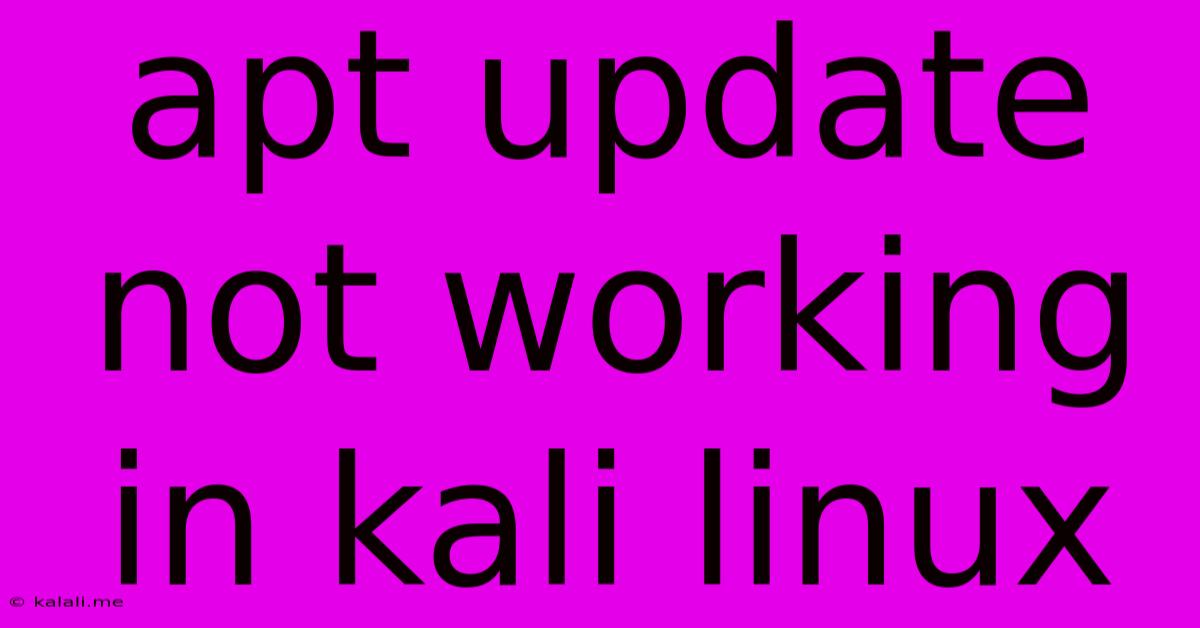Apt Update Not Working In Kali Linux
Kalali
Jun 04, 2025 · 4 min read

Table of Contents
Apt Update Not Working in Kali Linux: Troubleshooting and Solutions
This article addresses the frustrating issue of apt update failing in Kali Linux, a common problem for users. We'll explore common causes and provide effective solutions, ensuring your package manager is back online and you can install and update software smoothly. This guide covers various troubleshooting steps, from checking network connectivity to resolving repository issues. If you're encountering errors like E: Failed to fetch, W: Failed to fetch, or other update failures, this article is your go-to guide.
Why is apt update Failing?
The apt update command in Kali Linux synchronizes your local package lists with the official repositories. Failure can stem from several issues:
- Network Connectivity Problems: The most frequent cause. Your system might not be connected to the internet, have a weak connection, or be experiencing network outages.
- Repository Issues: Problems with the Kali Linux repositories themselves, such as temporary server downtime or corrupted repository data.
- Proxy Server Configuration: If you're behind a proxy, incorrect configuration can prevent
aptfrom accessing the repositories. - DNS Resolution Problems: Your system might be unable to resolve the domain names of the Kali repositories.
- Corrupted Local Package Lists: Outdated or damaged local package lists can hinder the update process.
- Insufficient Permissions: Lack of appropriate permissions can prevent
aptfrom accessing or modifying system files. - Firewall Interference: A firewall might be blocking access to the Kali repositories.
Troubleshooting Steps: Getting apt update Working Again
Here's a step-by-step guide to troubleshoot and resolve apt update failures in Kali Linux:
1. Verify Network Connectivity
This is the first and most crucial step. Ensure your Kali system is connected to the internet.
- Check your wired or wireless connection: Make sure the cable is securely plugged in or your Wi-Fi is connected with a strong signal.
- Ping a known working website: Open a terminal and type
ping google.com. Successful replies indicate network connectivity. If you get "Request timed out," your network connection needs attention. - Check your network configuration: Use commands like
ip addrorifconfigto verify your IP address and network settings.
2. Check the Kali Repositories
Sometimes, the problem lies with the Kali repositories themselves. While less common, temporary outages or issues can occur.
- Try
apt updateagain: Sometimes, a temporary glitch resolves itself. Try running the command again after a few minutes. - Check the Kali website: Visit the official Kali Linux website for any announcements regarding repository issues or maintenance.
3. Check and Configure Proxy Settings (if applicable)
If you're behind a proxy server, incorrect configuration can block apt.
- Check your proxy settings: Verify your proxy settings in your network configuration.
- Configure
aptto use the proxy: If necessary, configureaptto use your proxy server using thehttp_proxyandhttps_proxyenvironment variables. You can set these temporarily usingexportcommands before runningapt update, or permanently in your shell configuration file (e.g.,~/.bashrc).
4. Resolve DNS Resolution Issues
Problems resolving domain names can prevent apt from accessing the repositories.
- Check your DNS settings: Ensure your system is using a reliable DNS server. You can temporarily change your DNS server using the
resolv.conffile (be cautious when editing this file). - Flush your DNS cache: Run
sudo systemd-resolve --flush-cachesto clear any cached DNS entries.
5. Repair Corrupted Local Package Lists
Damaged local package lists can cause update failures.
- Run
apt cleanandapt update: Theapt cleancommand removes downloaded package files. Running this followed byapt updatecan often resolve issues. - Try
apt-get update: While functionally similar toapt update, sometimes this alternative command works whereapt updatefails.
6. Verify Permissions
Insufficient permissions can prevent apt from working correctly.
- Run
apt updatewithsudo: Always usesudo apt updateto ensure you have the necessary administrative privileges.
7. Check Firewall Settings
A firewall might be blocking access to the Kali repositories.
- Temporarily disable your firewall: If you suspect firewall interference, temporarily disable your firewall to test if it resolves the issue. Remember to re-enable it afterward.
8. Reinstall apt (Last Resort)
In rare cases, reinstalling apt might be necessary. However, this is a last resort and should only be attempted if all other steps fail. This is advanced and should only be done if you are comfortable with potential system instability.
By systematically working through these troubleshooting steps, you should be able to resolve the apt update issue in Kali Linux and get your system back up to date. Remember to always back up important data before making significant system changes.
Latest Posts
Latest Posts
-
Hot Surface Light Stays On Stove Dangerous
Jun 06, 2025
-
How To Make Sure You Messages Are Stored In Icloud
Jun 06, 2025
-
Symptoms Of Bad Hot Water Heater Element
Jun 06, 2025
-
Baking Soda Is Base Or Acid
Jun 06, 2025
-
Albert Einstein Blind Belief In Authority
Jun 06, 2025
Related Post
Thank you for visiting our website which covers about Apt Update Not Working In Kali Linux . We hope the information provided has been useful to you. Feel free to contact us if you have any questions or need further assistance. See you next time and don't miss to bookmark.